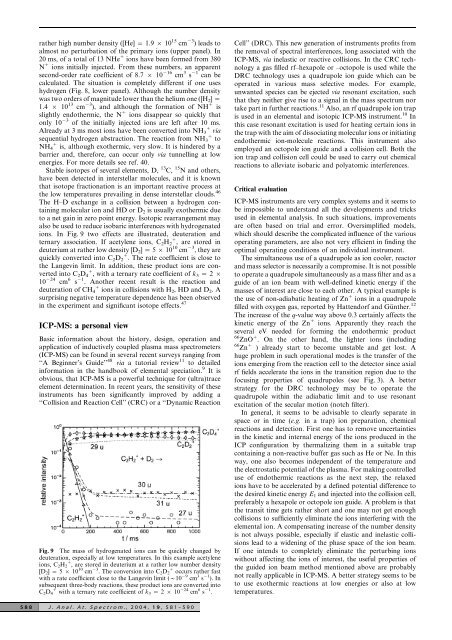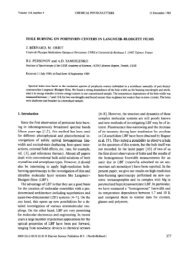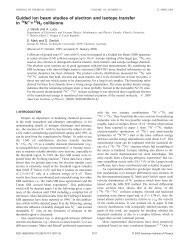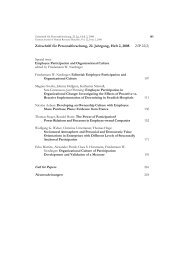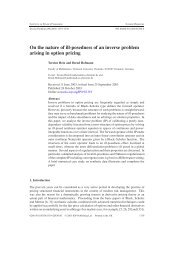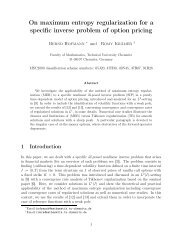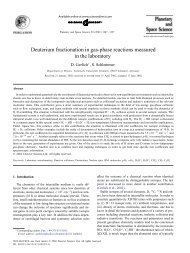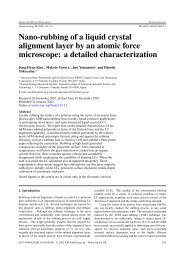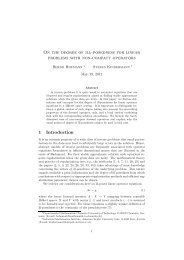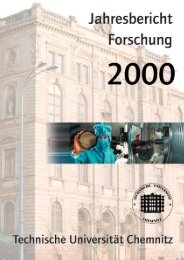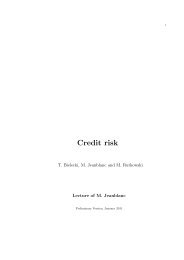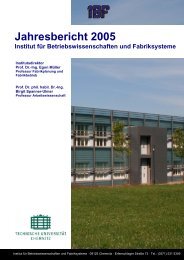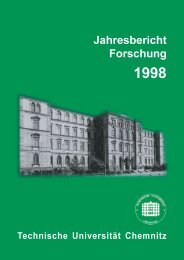Applications of rf fields and collision dynamics in atomic mass ...
Applications of rf fields and collision dynamics in atomic mass ...
Applications of rf fields and collision dynamics in atomic mass ...
Create successful ePaper yourself
Turn your PDF publications into a flip-book with our unique Google optimized e-Paper software.
ather high number density ([He] ~ 1.9 6 10 15 cm 23 ) leads to<br />
almost no perturbation <strong>of</strong> the primary ions (upper panel). In<br />
20 ms, <strong>of</strong> a total <strong>of</strong> 13 NHe 1 ions have been formed from 380<br />
N 1 ions <strong>in</strong>itially <strong>in</strong>jected. From these numbers, an apparent<br />
second-order rate coefficient <strong>of</strong> 8.7 6 10 216 cm 3 s 21 can be<br />
calculated. The situation is completely different if one uses<br />
hydrogen (Fig. 8, lower panel). Although the number density<br />
was two orders <strong>of</strong> magnitude lower than the helium one ([H2] ~<br />
1.4 6 10 13 cm 23 ), <strong>and</strong> although the formation <strong>of</strong> NH 1 is<br />
slightly endothermic, the N 1 ions disappear so quickly that<br />
only 10 23 <strong>of</strong> the <strong>in</strong>itially <strong>in</strong>jected ions are left after 10 ms.<br />
Already at 3 ms most ions have been converted <strong>in</strong>to NH 3 1 via<br />
sequential hydrogen abstraction. The reaction from NH3 1 to<br />
NH 4 1 is, although exothermic, very slow. It is h<strong>in</strong>dered by a<br />
barrier <strong>and</strong>, therefore, can occur only via tunnell<strong>in</strong>g at low<br />
energies. For more details see ref. 40.<br />
Stable isotopes <strong>of</strong> several elements, D, 13 C, 15 N <strong>and</strong> others,<br />
have been detected <strong>in</strong> <strong>in</strong>terstellar molecules, <strong>and</strong> it is known<br />
that isotope fractionation is an important reactive process at<br />
the low temperatures prevail<strong>in</strong>g <strong>in</strong> dense <strong>in</strong>terstellar clouds. 46<br />
The H–D exchange <strong>in</strong> a <strong>collision</strong> between a hydrogen conta<strong>in</strong><strong>in</strong>g<br />
molecular ion <strong>and</strong> HD or D 2 is usually exothermic due<br />
to a net ga<strong>in</strong> <strong>in</strong> zero po<strong>in</strong>t energy. Isotopic rearrangement may<br />
also be used to reduce isobaric <strong>in</strong>te<strong>rf</strong>erences with hydrogenated<br />
ions. In Fig. 9 two effects are illustrated, deuteration <strong>and</strong><br />
ternary association. If acetylene ions, C 2H 2 1 , are stored <strong>in</strong><br />
deuterium at rather low density [D2] ~ 5 6 10 10 cm 23 , they are<br />
quickly converted <strong>in</strong>to C 2D 2 1 . The rate coefficient is close to<br />
the Langev<strong>in</strong> limit. In addition, these product ions are converted<br />
<strong>in</strong>to C 2D 4 1 , with a ternary rate coefficient <strong>of</strong> k3 ~ 2 6<br />
10 224 cm 6 s 21 . Another recent result is the reaction <strong>and</strong><br />
deuteration <strong>of</strong> CH 4 1 ions <strong>in</strong> <strong>collision</strong>s with H2, HD <strong>and</strong> D 2.A<br />
surpris<strong>in</strong>g negative temperature dependence has been observed<br />
<strong>in</strong> the experiment <strong>and</strong> significant isotope effects. 47<br />
ICP-MS: a personal view<br />
Basic <strong>in</strong>formation about the history, design, operation <strong>and</strong><br />
application <strong>of</strong> <strong>in</strong>ductively coupled plasma <strong>mass</strong> spectrometers<br />
(ICP-MS) can be found <strong>in</strong> several recent surveys rang<strong>in</strong>g from<br />
‘‘A Beg<strong>in</strong>ner’s Guide’’ 48 via a tutorial review 11 to detailed<br />
<strong>in</strong>formation <strong>in</strong> the h<strong>and</strong>book <strong>of</strong> elemental speciation. 9 It is<br />
obvious, that ICP-MS is a powe<strong>rf</strong>ul technique for (ultra)trace<br />
element determ<strong>in</strong>ation. In recent years, the sensitivity <strong>of</strong> these<br />
<strong>in</strong>struments has been significantly improved by add<strong>in</strong>g a<br />
‘‘Collision <strong>and</strong> Reaction Cell’’ (CRC) or a ‘‘Dynamic Reaction<br />
Fig. 9 The <strong>mass</strong> <strong>of</strong> hydrogenated ions can be quickly changed by<br />
deuteration, especially at low temperatures. In this example acetylene<br />
ions, C2H2 1 , are stored <strong>in</strong> deuterium at a rather low number density<br />
[D2] ~ 5 6 10 10 cm 23 . The conversion <strong>in</strong>to C2D2 1 occurs rather fast<br />
with a rate coefficient close to the Langev<strong>in</strong> limit (y10 29 cm 3 s 21 ). In<br />
subsequent three-body reactions, these product ions are converted <strong>in</strong>to<br />
C 2D 4 1 with a ternary rate coefficient <strong>of</strong> k3 ~ 2 6 10 224 cm 6 s 21 .<br />
588 J. Anal. At. Spectrom., 2004, 19, 581–590<br />
Cell’’ (DRC). This new generation <strong>of</strong> <strong>in</strong>struments pr<strong>of</strong>its from<br />
the removal <strong>of</strong> spectral <strong>in</strong>te<strong>rf</strong>erences, long associated with the<br />
ICP-MS, via <strong>in</strong>elastic or reactive <strong>collision</strong>s. In the CRC technology<br />
a gas filled <strong>rf</strong>–hexapole or –octopole is used while the<br />
DRC technology uses a quadrupole ion guide which can be<br />
operated <strong>in</strong> various <strong>mass</strong> selective modes. For example,<br />
unwanted species can be ejected via resonant excitation, such<br />
that they neither give rise to a signal <strong>in</strong> the <strong>mass</strong> spectrum nor<br />
take part <strong>in</strong> further reactions. 11 Also, an <strong>rf</strong> quadrupole ion trap<br />
is used <strong>in</strong> an elemental <strong>and</strong> isotopic ICP-MS <strong>in</strong>strument. 10 In<br />
this case resonant excitation is used for heat<strong>in</strong>g certa<strong>in</strong> ions <strong>in</strong><br />
the trap with the aim <strong>of</strong> dissociat<strong>in</strong>g molecular ions or <strong>in</strong>itiat<strong>in</strong>g<br />
endothermic ion-molecule reactions. This <strong>in</strong>strument also<br />
employed an octopole ion guide <strong>and</strong> a <strong>collision</strong> cell. Both the<br />
ion trap <strong>and</strong> <strong>collision</strong> cell could be used to carry out chemical<br />
reactions to alleviate isobaric <strong>and</strong> poly<strong>atomic</strong> <strong>in</strong>te<strong>rf</strong>erences.<br />
Critical evaluation<br />
ICP-MS <strong>in</strong>struments are very complex systems <strong>and</strong> it seems to<br />
be impossible to underst<strong>and</strong> all the developments <strong>and</strong> tricks<br />
used <strong>in</strong> elemental analysis. In such situations, improvements<br />
are <strong>of</strong>ten based on trial <strong>and</strong> error. Oversimplified models,<br />
which should describe the complicated <strong>in</strong>fluence <strong>of</strong> the various<br />
operat<strong>in</strong>g parameters, are also not very efficient <strong>in</strong> f<strong>in</strong>d<strong>in</strong>g the<br />
optimal operat<strong>in</strong>g conditions <strong>of</strong> an <strong>in</strong>dividual <strong>in</strong>strument.<br />
The simultaneous use <strong>of</strong> a quadrupole as ion cooler, reactor<br />
<strong>and</strong> <strong>mass</strong> selector is necessarily a compromise. It is not possible<br />
to operate a quadrupole simultaneously as a <strong>mass</strong> filter <strong>and</strong> as a<br />
guide <strong>of</strong> an ion beam with well-def<strong>in</strong>ed k<strong>in</strong>etic energy if the<br />
<strong>mass</strong>es <strong>of</strong> <strong>in</strong>terest are close to each other. A typical example is<br />
the use <strong>of</strong> non-adiabatic heat<strong>in</strong>g <strong>of</strong> Zn 1 ions <strong>in</strong> a quadrupole<br />
filled with oxygen gas, reported by Hattendo<strong>rf</strong> <strong>and</strong> Günther. 12<br />
The <strong>in</strong>crease <strong>of</strong> the q-value way above 0.3 certa<strong>in</strong>ly affects the<br />
k<strong>in</strong>etic energy <strong>of</strong> the Zn 1 ions. Apparently they reach the<br />
several eV needed for form<strong>in</strong>g the endothermic product<br />
66 ZnO 1 . On the other h<strong>and</strong>, the lighter ions (<strong>in</strong>clud<strong>in</strong>g<br />
66 Zn 1 ) already start to become unstable <strong>and</strong> get lost. A<br />
huge problem <strong>in</strong> such operational modes is the transfer <strong>of</strong> the<br />
ions emerg<strong>in</strong>g from the reaction cell to the detector s<strong>in</strong>ce axial<br />
<strong>rf</strong> <strong>fields</strong> accelerate the ions <strong>in</strong> the transition region due to the<br />
focus<strong>in</strong>g properties <strong>of</strong> quadrupoles (see Fig. 3). A better<br />
strategy for the DRC technology may be to operate the<br />
quadrupole with<strong>in</strong> the adiabatic limit <strong>and</strong> to use resonant<br />
excitation <strong>of</strong> the secular motion (notch filter).<br />
In general, it seems to be advisable to clearly separate <strong>in</strong><br />
space or <strong>in</strong> time (e.g. <strong>in</strong> a trap) ion preparation, chemical<br />
reactions <strong>and</strong> detection. First one has to remove uncerta<strong>in</strong>ties<br />
<strong>in</strong> the k<strong>in</strong>etic <strong>and</strong> <strong>in</strong>ternal energy <strong>of</strong> the ions produced <strong>in</strong> the<br />
ICP configuration by thermaliz<strong>in</strong>g them <strong>in</strong> a suitable trap<br />
conta<strong>in</strong><strong>in</strong>g a non-reactive buffer gas such as He or Ne. In this<br />
way, one also becomes <strong>in</strong>dependent <strong>of</strong> the temperature <strong>and</strong><br />
the electrostatic potential <strong>of</strong> the plasma. For mak<strong>in</strong>g controlled<br />
use <strong>of</strong> endothermic reactions as the next step, the relaxed<br />
ions have to be accelerated by a def<strong>in</strong>ed potential difference to<br />
the desired k<strong>in</strong>etic energy E1 <strong>and</strong> <strong>in</strong>jected <strong>in</strong>to the <strong>collision</strong> cell,<br />
preferably a hexapole or octopole ion guide. A problem is that<br />
the transit time gets rather short <strong>and</strong> one may not get enough<br />
<strong>collision</strong>s to sufficiently elim<strong>in</strong>ate the ions <strong>in</strong>te<strong>rf</strong>er<strong>in</strong>g with the<br />
elemental ion. A compensat<strong>in</strong>g <strong>in</strong>crease <strong>of</strong> the number density<br />
is not always possible, especially if elastic <strong>and</strong> <strong>in</strong>elastic <strong>collision</strong>s<br />
lead to a widen<strong>in</strong>g <strong>of</strong> the phase space <strong>of</strong> the ion beam.<br />
If one <strong>in</strong>tends to completely elim<strong>in</strong>ate the perturb<strong>in</strong>g ions<br />
without affect<strong>in</strong>g the ions <strong>of</strong> <strong>in</strong>terest, the useful properties <strong>of</strong><br />
the guided ion beam method mentioned above are probably<br />
not really applicable <strong>in</strong> ICP-MS. A better strategy seems to be<br />
to use exothermic reactions at low energies or also at low<br />
temperatures.


